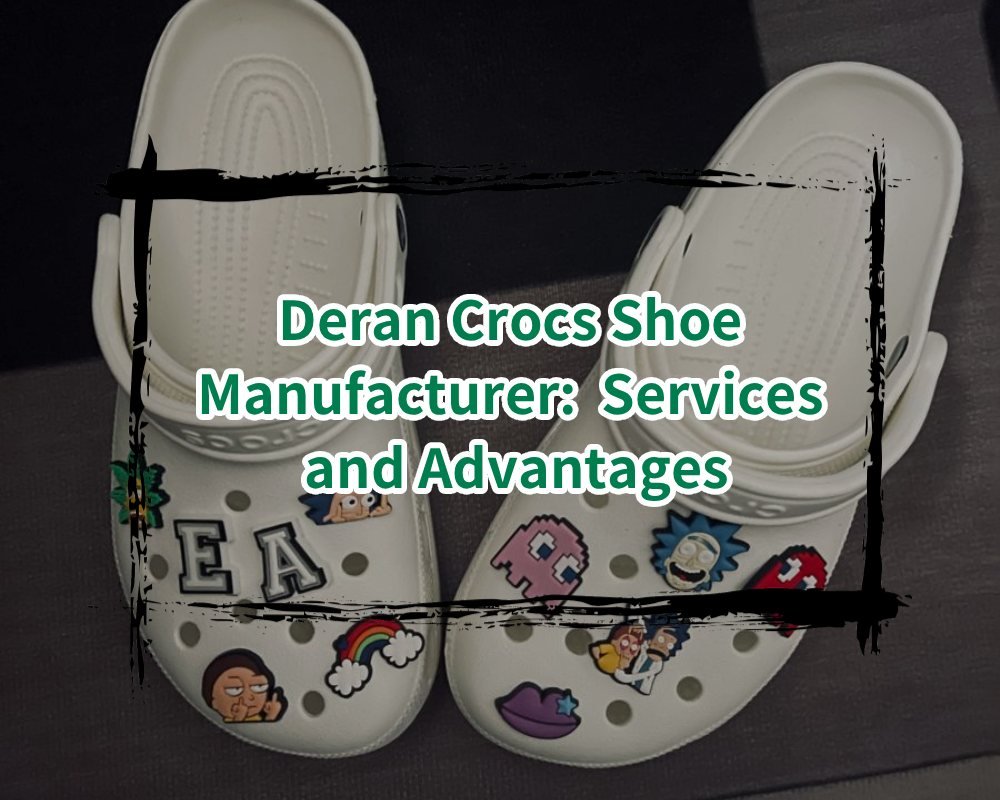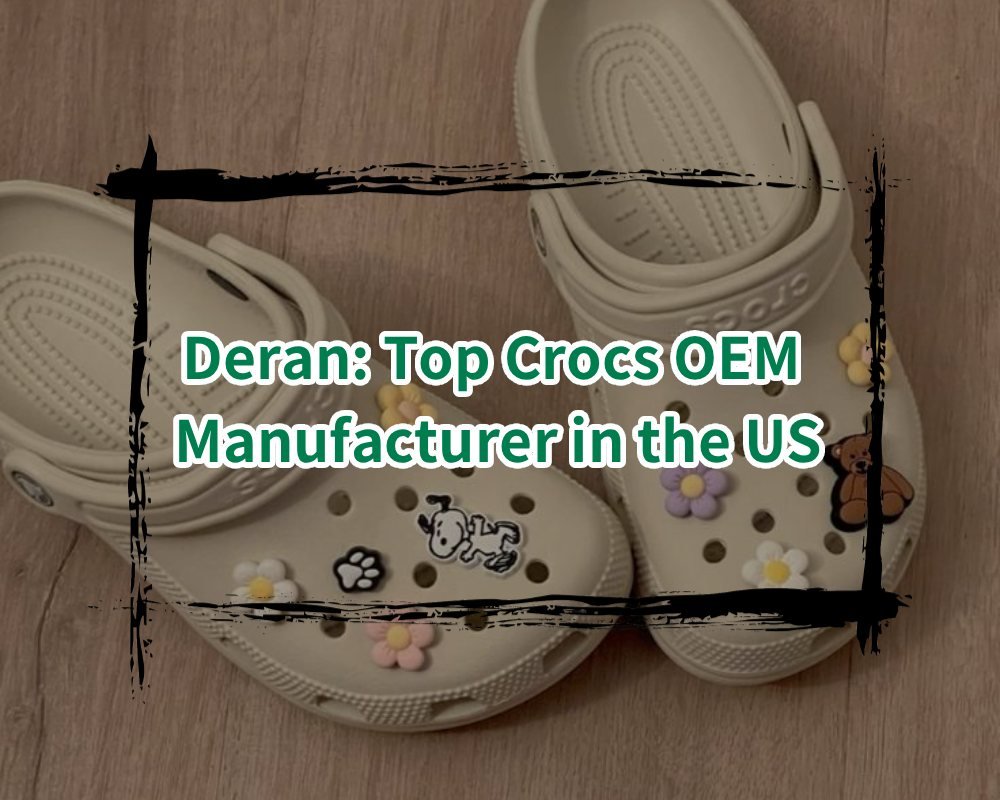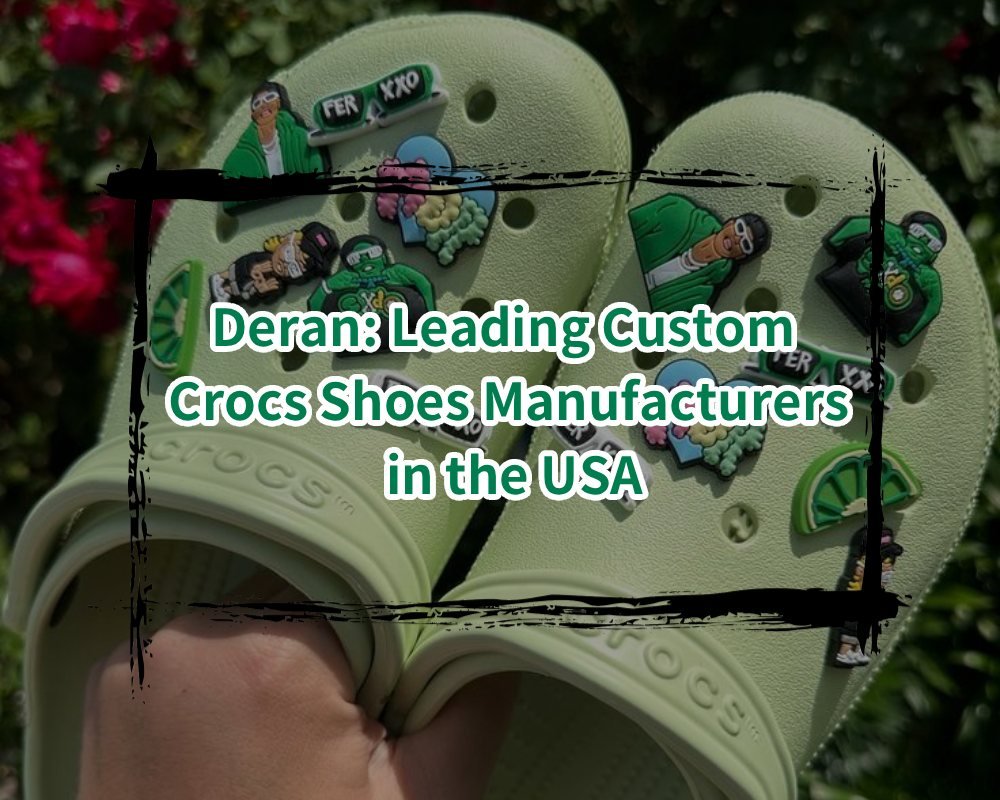Table of contents
- What are Crocs Charms? Understanding Their Structure and Types
- Preparing for Crocs Charm Design: From Inspiration to Digitalization
- Recommended Tools and Materials for Making Crocs Charms
- Crocs Charms Production Process Detailed: From Prototype to Mass Production
- Common Problems and Solutions: Avoiding Common Mistakes
In today’s fast-paced, highly personalized consumer world, people are increasingly expressing themselves through details. Crocs, once considered an ugly pair of plastic clogs, has recently become a fashion trend with its comfort and customizable upper. Crocs Charms (also known as Jibbitz shoe buckles) are a core element of this trend.
So, how do you turn an interesting idea into a wearable and resalable Crocs Charm? Deran croc wholesale suppliers will uncover the secrets behind its production, step by step, from design concepts, tools and materials, production process, to practical tips.
What are Crocs Charms? Understanding Their Structure and Types
Crocs Charms, also known as Jibbitz, are accessories designed specifically for Crocs shoes. They insert into small holes in the upper of Crocs shoes through a pin structure on the bottom, creating a decorative effect.
Basic Structure
A standard Crocs Charm typically consists of two parts:
- Decorative Body: This is the surface pattern we see, typically made of PVC, silicone, acrylic, or metal.
- Snap-in Plug: This is the snap-in plug that inserts into the upper shoe and secures the charm. It’s typically made of flexible TPU, approximately 8-10mm in diameter, and stays firmly in place.
Common Types
- Soft PVC: The most common type, featuring rich colors, three-dimensional patterns, and low production cost.
- Acrylic Laser: Using laser cutting technology, the pattern is flattened and has a glossy finish.
- Epoxy Transparent: Using a printed image as the base, covered with a transparent PU epoxy cover, creating a badge-like texture.
- Metal Charm: Attaching a small metal pendant to the snap-in plug creates a more premium feel.
- Functional Charms: Creative products such as luminous, scented, and fidget spinner-shaped charms.
As user needs diversify, Crocs Charms have evolved from simple decorative features to cultural expression, interactive entertainment, and even collectible value.
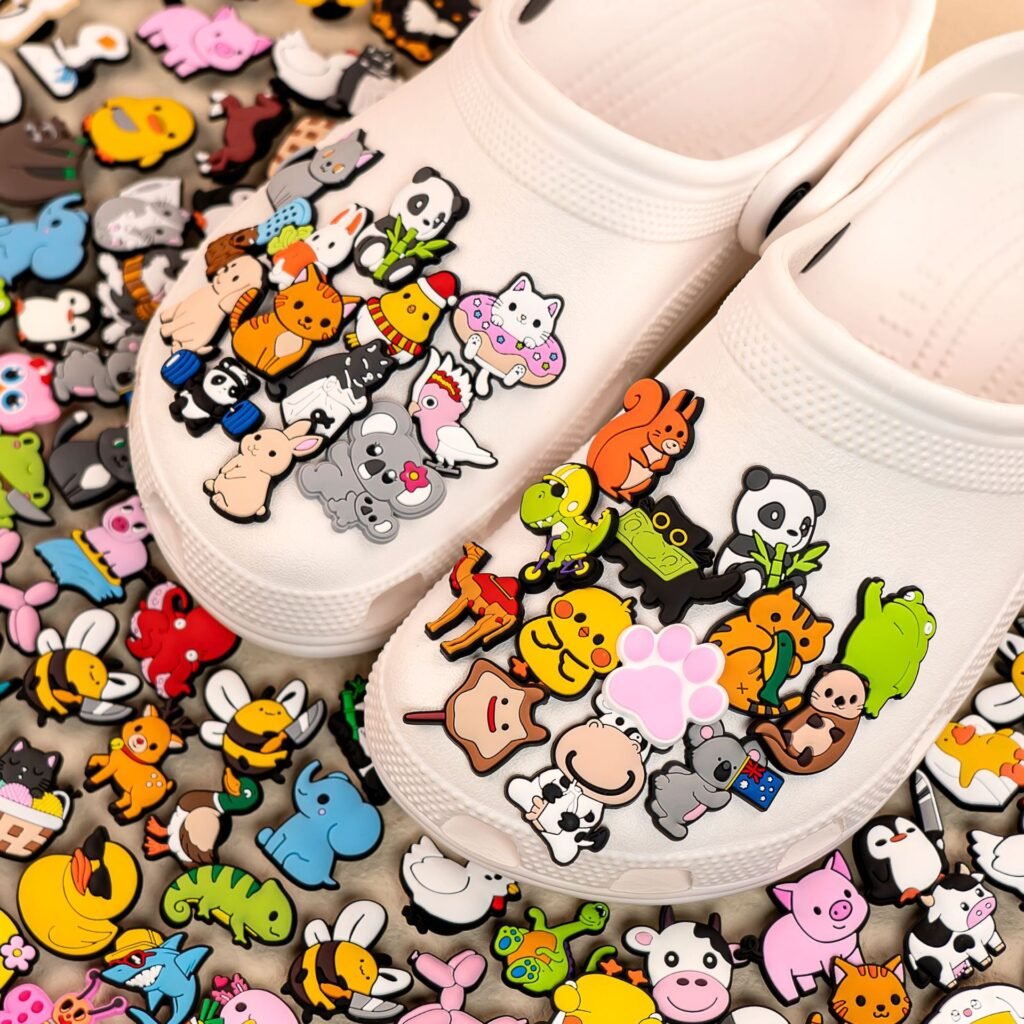
Preparing for Crocs Charm Design: From Inspiration to Digitalization
The first step in making Crocs Charms is design. Even the best materials won’t capture attention without a creative design.
Sources of Inspiration
Design inspiration can be obtained from the following sources:
- Pinterest & Instagram: Search keywords like “crocs charms aesthetic” and “kawaii charms design” to access the latest global style trends.
- Etsy Hot Seller Analysis: Understand market preferences by observing popular designs and customer reviews on Etsy.
- TikTok Trends: Focus on topics young people are discussing, such as cartoon characters, buzzwords, and rising idols.
Drawing Tools
- Beginner Recommendation: Hand-drawn sketches + mobile phone photography + simple Photoshop editing.
- Expert Recommendation: Use Procreate (iPad) or Adobe Illustrator for vector drawing, which will facilitate mold precision control in the later stages.
Design Key Points
- Size Control: Main images should ideally be kept within 3cm; width should not exceed 3.2cm, otherwise they may fall off.
- Content Composition: Avoid overly thin structures (such as thin, long whiskers), as they can break easily.
- Color Combination: Refer to Pantone color charts or Adobe Color to create a combination of highly saturated, clearly defined color blocks.
After establishing a character or pattern library, you can move on to the proofing stage. It’s also recommended to develop multiple themes, such as holiday collections, animal collections, and trendy collections, to increase market reach.
Recommended Tools and Materials for Making Crocs Charms
Once the design is complete, you need to prepare the materials and tools to begin production. This section will cover both manual and digital production.
Common Materials List
| Material | Properties | Applicable Categories |
| PVC Soft Rubber | Soft, colorable, low-cost | Injection Molding |
| TPU Plastic | Strong elasticity, high transparency | Pin structure |
| PU Epoxy | Waterproof, surface gloss protection | Epoxy Decorations |
| Acrylic Sheet | Laser-cuttable | Laser Finish |
| Resin | High hardness, dyeable | Handmade in small batches |
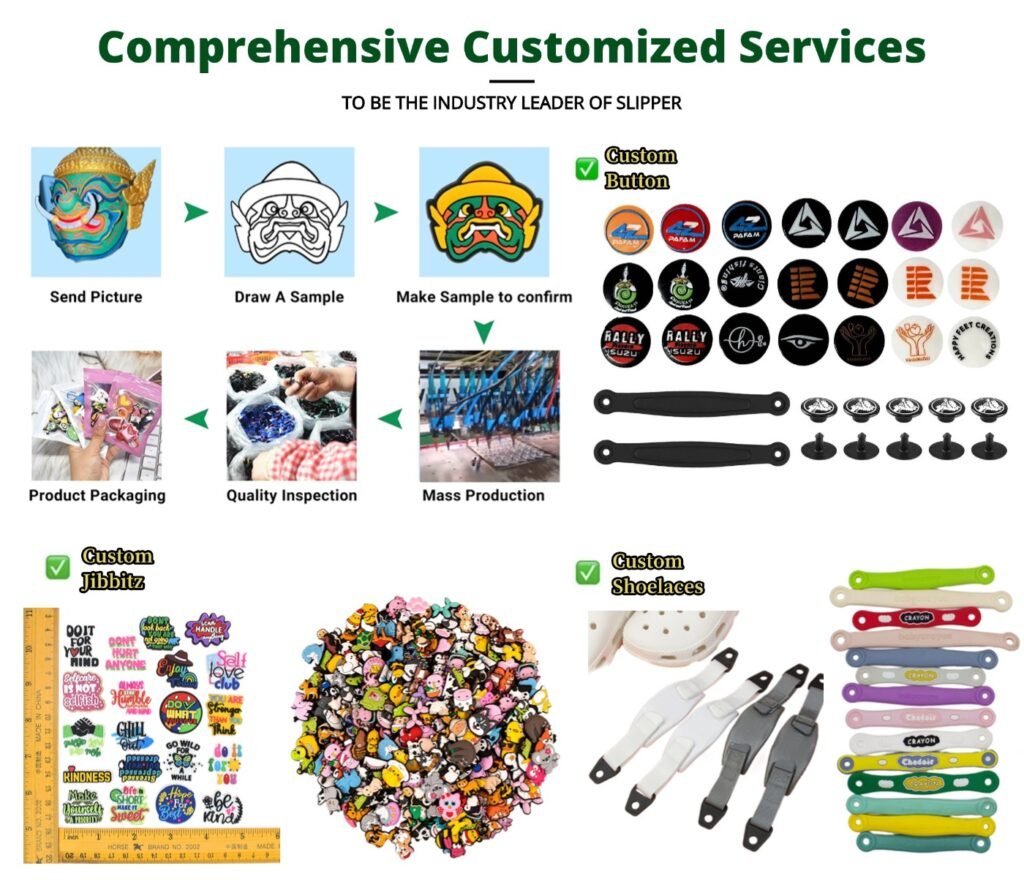
Crocs Charms Production Process Detailed: From Prototype to Mass Production
Single Prototype Process
- Import the design into modeling software for 3D modeling.
- Use 3D printing or silicone molds for preliminary molding.
- Inject color or coating for appearance testing.
- Attach to the pin base for secure fit verification.
Color Matching and Mold Development
- Use the Pantone color matching system for color matching.
- Mold costs range from approximately 500 to 1500 yuan per design, depending on the complexity of the design.
- Most manufacturers require a minimum order of 50-100 pieces before starting mold production.
Surface Treatment
- Glossy Finish: Conventional polishing or injection molding for a natural gloss.
- Epoxy Cover: Creates a mirror-like look and feel.
- Matt UV Spray: Anti-fingerprint and scratch-resistant.
Volume Production Recommendations
- Minimum Order Quantity (MOQ): The standard MOQ is 500 pieces per style, though some smaller factories may accept orders of 100 pieces.
- Production Lead Time: From proofing to delivery, it typically takes 15-20 days.
- Quality Inspection: Includes tensile testing (to ensure pins resist falling off), color fastness testing (to prevent sun fading), and environmental certification (RoHS/REACH, etc.).
Common Problems and Solutions: Avoiding Common Mistakes
Pins Breaking Easily?
- Cause: The pin material is too hard or the base thickness is improperly designed.
- Solution: Use flexible TPU material, with a recommended thickness of no more than 2.5mm.
Excessive Color Deviation?
- Cause: Inaccurate color matching or large batch variations.
- Solution: Record the color ratio for each batch and use Pantone color charts for comparison and calibration.
Is the mold prone to wear?
- Cause: Lack of maintenance or overly complex design.
- Solution: Regularly oil the mold after use, store in a dry environment, and separate complex designs into separate pieces.
Is the customer’s design suspected of copyright infringement?
- We recommend that the customer sign a design authorization statement to avoid counterfeiting well-known brands or character IPs.
Unable to export to Europe or the United States?
- We recommend applying for relevant certifications (such as CE Mark, EN71, ASTM-F963) in advance and requesting safety reports from material suppliers.
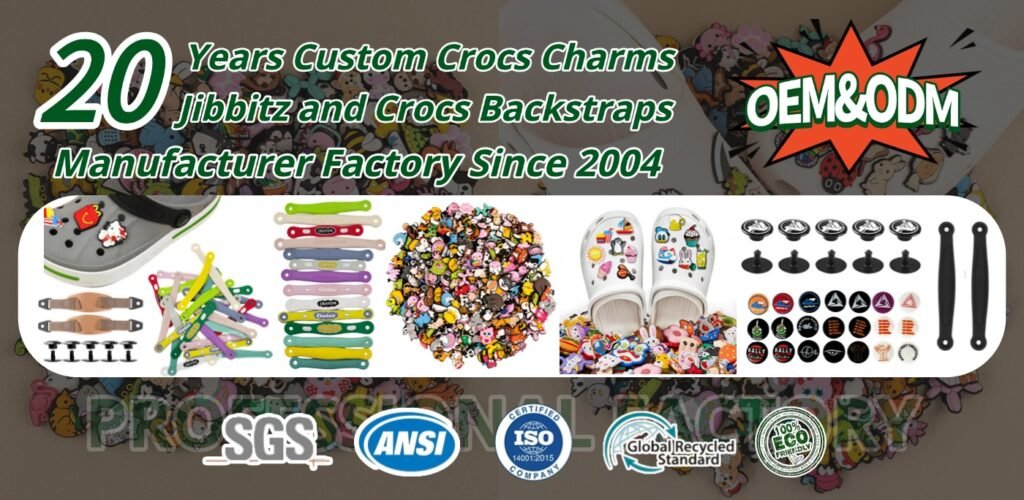
| OEM&ODM Factory | Email: sarah@clogsslipper.com | Whatapp: +8613960916317 |
Wholesale custom jibbitz are more than just decoration; they are a form of self-expression. Once you master the entire process from design to production, you can not only create your own unique accessories but also develop them into a marketable, creative, and profitable brand project.
Whether you are a solo creator, a micro-business owner, or a startup brand, with patience, creativity, and the right approach, Crocs Charms will be a promising creative path.
Now, it’s time to start working on your first design.



